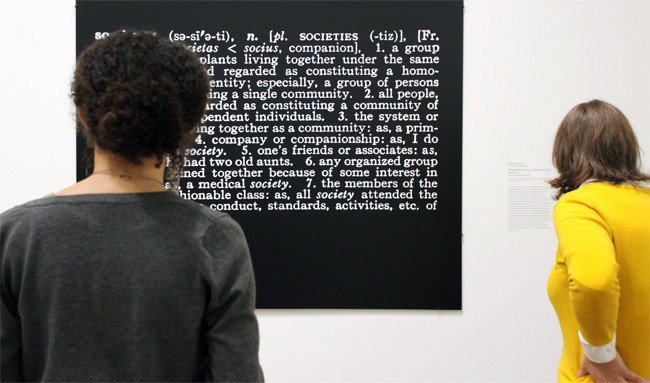When high school teacher Elizabeth Menges brought her art students from nearby Cambridge Rindge and Latin School (CRLS) to the Harvard Art Museums this spring, the students weren’t the only ones acquiring new knowledge. As part of a Graduate Student Teacher internship, six Harvard Graduate School of Education (HGSE) student teachers were gaining valuable hands-on experience in lesson planning and facilitating group discussions. David Odo, the museums’ director of student programs and research curator for university collections initiatives, oversees the program.
“The Graduate Student Teacher internship harnesses the resources of CRLS, the museums, and HGSE,” said Odo. “The museums and HGSE work together to provide pedagogical training with in-depth research into the collections. At CRLS, Elizabeth Menges not only provides expert mentorship to our graduate students, but also collaborates with us to create an extremely open environment for teaching and learning.”
The graduate students completed the internship during the 2014–15 academic year, as part of their HGSE coursework. (Five of the students are enrolled in the Arts in Education Program, while one is in the Language and Literacy Program.) They were selected for their experience in working with high school students—either in museums or the classroom—and for their interest in furthering their skills and pursuing careers in objects-based teaching.
“It has been such an amazing experience learning from the students,” said Angela Fisher, who hopes to work in learning and curriculum design after she earns her master’s degree. “I knew I would be teaching and sharing art with the students, but I had no idea how much they would be sharing with me and with each other.” Fisher and Alexandra Checka worked with Menges’s students in a Foundations of Art class. (Another pair, Correna Cohen and Maya Gomez, works with a second Foundations class, while a third pair, Sarah Quinn Ezzarghani and Stacey Kahn, works with a studio art class.)
CRLS freshman Jack Deford said he was coming away with a new ability: “to notice more specific details of the art.” His classmate Miya Duffy said the gallery visits made her work in the classroom more meaningful, and conversely, her time creating art in Menges’s class has “made it easier to look at art” in the museums. Duffy said she doesn’t visit museums much, but “I actually really like coming here,” and she would probably return on her own (taking advantage of the museums’ free admission policy for all Cambridge residents). “It’s fun to come here with friends,” she said.
The graduate student teachers made a number of visits to CRLS during the fall and winter to introduce themselves and the Harvard Art Museums, and to get to know the students. In the spring, they worked with Menges to plan lessons for visits to the museums that would complement the students’ classroom work and add the crucial dimension of experiencing original works of art.
Through a series of trips to the museums, the graduate student teachers led the CRLS students through lessons on such topics as line and shading, color, and inspiration. They had the students view a diverse selection of objects, from around the world and encompassing a broad span of time periods, materials, and styles. They prompted discussions and oversaw short, on-site drawing assignments. The teachers also helped the groups explore conceptual topics, such as breaking rules and being inspired by other artists. The classes’ final assignments, due this month to Menges, will be to create original art inspired by objects in the museums’ collections.
“This is a good way to combine studio time in the classroom with what my students have been exposed to in the museums,” Menges said. The experience of working with graduate student teachers involves “learning on my part and on their part. I give them feedback after every visit. I feel like they’ve learned a lot about how to teach in a museum setting while understanding the greater context of each student as a person.”
An important takeaway for the CRLS students, Menges said, has been broadening their appreciation of art, particularly for some who may have started the visits thinking art is boring, or that art takes only one form or can have only one meaning. “My hope is that we’ve had enough facilitated conversations about art that they don’t feel like there’s a wall between them and the artwork,” Menges said, “that they can actually look at it, talk about it, and feel that they have valid things to say.”
That proved to be the case on one particularly memorable visit, Angela Fisher said. “We were standing in front of Mark Rothko’s Harvard Murals, and we were talking about the conservation of the works. One student said, ‘Why?’ So we dug a little deeper: ‘What do you mean, why?’ He said, ‘Why are we preserving these artworks, over all the other artworks? Why is so much effort put into helping us see how these originally were?’ And that brought this really rich, wonderful discussion about the value of art, what different art means for different time periods, and what value there is in artwork that we don’t immediately understand.”
Fisher continued: “It’s really wonderful that they feel free to ask questions about art. The students have become more open in sharing their thoughts, and I think that’s a result of this program.”
Odo is impressed by how both sets of students became “empowered to, in effect, co-create the program. It has been tremendous to see the new museums function equally well for students of all levels as a place of creative exploration and learning,” he said.



